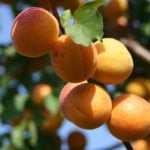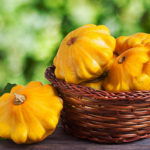Tomatoes (Lycopersicon esculentum) – pubescent annual herbaceous plant with erect, ascending or recumbent, branched stems, height from 50-80 (1.6-2.6 feet) to 300 (9.8 feet) or more centimeters. This bright representative of the Solanaceae family from South America.
The leaves are unpaired, smooth to strongly corrugated, light or dark green. The flowers are yellow, collected in a whorl of inflorescence; they bloom in June-August. Fruits-juicy, spherical, elongated, pear-shaped, flattened, ribbed, red, crimson, pink, purple, orange, yellow or white berries; ripen in July-September. Especially decorative are strong-growing, cherry-shaped varieties with a brush from simple (5-10 fruits) to super-complex (several hundred) with red, yellow, orange, pink fruits. Especially decorative are the multi-flowered, small-fruited varieties Solanum pimpinellifolium and Lycopersicon esculentum var pyriforme, as well as cherry tomatoes: ‘Tumblr’ (a very early variety, sweet and fragrant, which will replace the decorative basket plant in hanging baskets with its numerous bright red fruits), ‘DeBarao’ (tall, with oval fruits, red, yellow, pink and even black), ‘F1 Diplom’(fragrant, early, with bright round fruits), ‘Tigerella’ (bi-color (brindle), with stripes of lighter color, especially noticeable on unripe fruits), “Firefly” (carpal, with small red fruits), ‘F1 DolceVita’ (wrist, red fruit) ‘’ YellowPlum’ (wrist, yellow fruit) ‘ ‘butterfly’ (fruits oblong, pink, sticking up, multi-flowered brush) ‘ ‘F1 Roksalana’ (wrist, round fruits ripen simultaneously). Most of them are resistant to fungal diseases.

Depending on the height of the variety, it can be used on garden soil, flower or vegetable mixborder, vertical culture with the use of supports as a focal plant during the ripening period . The distance between the plants is 20-50 cm (7.9-19.6 inches), depending on the strength of growth, the planting depth is 1.5-3 cm (0.6-1.2 inches). They prefer loose, fertile, moisture-intensive, slightly acidic and neutral soils. The best predecessors: annual legumes, onions, early cabbage, cucumbers.
Tomato is not only a widely cultivated vegetable, but also a medicinal, ornamental plant. For consumption, fresh or processed fruits (salads, pickles, seasonings, dressings, pasta, juices) improve digestion, saturating the body with vitamins that are useful in dietary nutrition for disorders of blood circulation, hematopoiesis, metabolism, gout, rheumatism, obesity, diseases of the kidneys, liver, bile ducts, cardiovascular system, etc. It should be used carefully if you have gallstones.


















